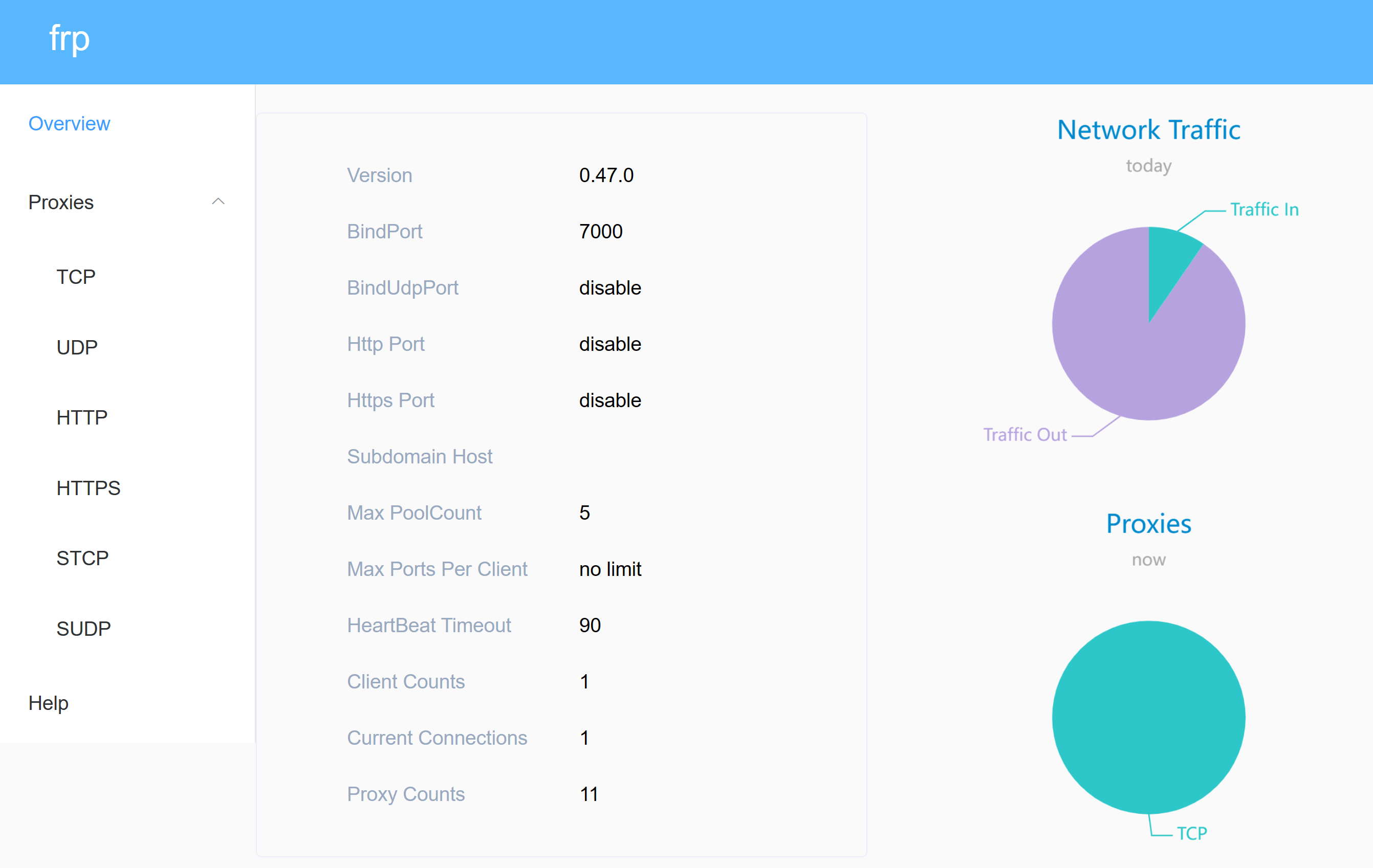Homelab - Tool for Intranet Penetration frp

frp is a method for intranet penetration. You can expose the ports of your intranet hosts to the internet through a server with a public IP. frp supports various protocols such as TCP, UDP, HTTP, and HTTPS.
Deploying the server-side frps (Docker Compose)
First, create a compose.yaml file and paste the following content:
version: "3"
services:
frps:
container_name: ${STACK_NAME}_app
image: fatedier/frps:${APP_VERSION}
network_mode: host
volumes:
- ${STACK_DIR}/frps.toml:/etc/frp/frps.toml
command: "-c /etc/frp/frps.toml"
restart: always
(Optional) It is recommended to create a .env file in the same directory as compose.yaml and customize your environment variables. If you prefer not to use environment variables, you can also directly customize your parameters in compose.yaml (for example, replace ${STACK_NAME} with frps).
STACK_NAME=frps
STACK_DIR=/DATA/AppData/frps # Customize the project storage path, for example, ./frps
# frps
APP_VERSION=v0.56.0
Add a configuration file frps.ini in your project storage path ${STACK_DIR}:
bindAddr = "0.0.0.0"
bindPort = 7000 # The frp port open on the server, which must match the settings of frpc later
kcpBindPort = 7000
transport.maxPoolCount = 5
webServer.addr = "0.0.0.0" # Address of the panel, must be 0.0.0.0 for external access
webServer.port = 7500 # Port of the frps panel
webServer.user = "xxxxxx" # Panel username
webServer.password = "xxxxxx" # Password
auth.method = "token"
auth.token = "xxxxxx" # Custom token, which must match frpc
allowPorts = [
{ start = 2000, end = 3000 },
{ single = 3001 },
{ single = 3003 },
{ start = 4000, end = 50000 }
]
Finally, run the command docker compose up -d in the same directory as compose.yaml to start the orchestrated container.
If you prefer not to use Docker, you can also refer to this article: Server Configuration·How to achieve external RDP remote control (frp).
Deploying the client-side frpc (Docker Compose)
First, create a compose.yaml file and paste the following content:
version: "3"
services:
frpc:
container_name: ${STACK_NAME}_app
image: fatedier/frpc:${APP_VERSION}
network_mode: host
volumes:
- ${STACK_DIR}/frpc.toml:/etc/frp/frpc.toml
command: "-c /etc/frp/frpc.toml"
restart: always
(Optional)It is recommended to create a .env file in the same directory as compose.yaml and customize your environment variables. If you prefer not to use environment variables, you can directly customize your parameters in compose.yaml (e.g., replace ${STACK_NAME} with frpc).
STACK_NAME=frpc
STACK_DIR=/DATA/AppData/frpc # Customize your project storage path, e.g., ./frpc
# frpc
APP_VERSION=v0.56.0
Add a configuration file frps.toml in your project storage path ${STACK_DIR}:
user = "client-device-1" # Current device name
serverAddr = xx.xx.xx.xx # Public IP of the server
serverPort = 7000 # frp port opened by the server, should match the settings in frps
auth.method = "token"
auth.token = "xxxxxx" # Should match the settings in frps
transport.poolCount = 5
[[proxies]]
name = "app-name" # Application name
type = "tcp"
remotePort = xx # Public access port number
localIP = "127.0.0.1"
localPort = xx # Local port number
Finally, run the command docker compose up -d in the same directory as compose.yaml to start the orchestrated containers.
Configuration Notes
Please make sure that the Toml files are correctly formatted, otherwise the services cannot be started properly. You can use an online Toml editor and validator to check.
References and Acknowledgements
- GitHub repo · fatedier/frp
- GitHub repo · snowdreamtech/frps
- GitHub repo · stilleshan/frpc
- Docker Hub · snowdreamtech/frps
- Docker Hub · stilleshan/frpc
- How to implement external RDP remote control (frp)
- Access Synology NAS using frp
Dirección original del artículo: https://wiki-power.com/
Este artículo está protegido por la licencia CC BY-NC-SA 4.0. Si desea reproducirlo, por favor indique la fuente. ```Este post está traducido usando ChatGPT, por favor feedback si hay alguna omisión.